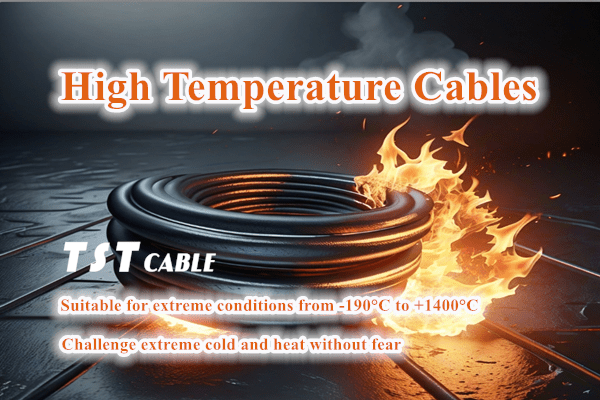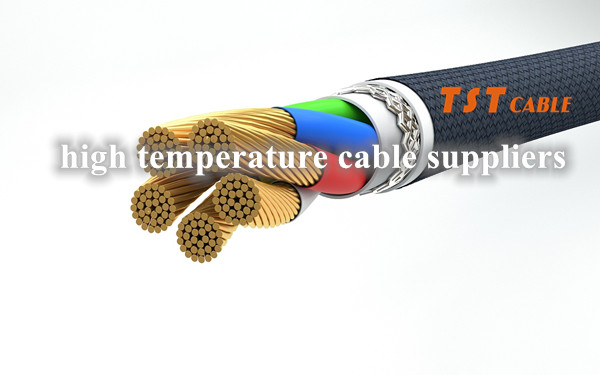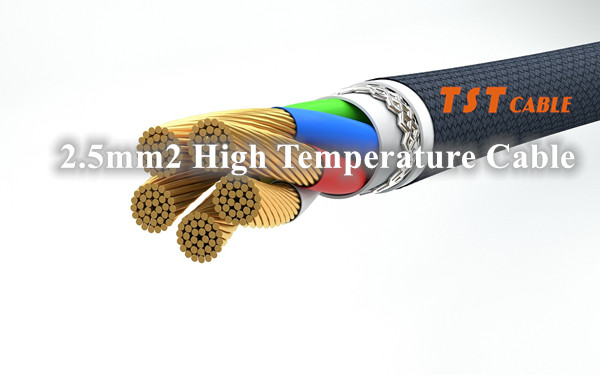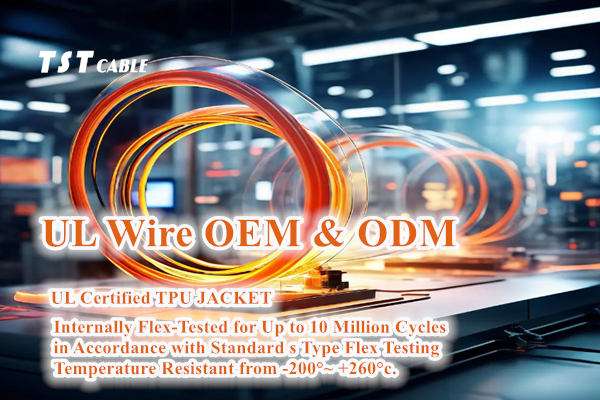High temperature cable and special cable are cables with special properties and uses. They can be classified according to different standards. TST CABLES classifies special cables according to their functions, application areas, performance characteristics, etc.

1. Classification by function
Flame retardant cable (ZR): In the event of a fire, it can slow down the spread of flames.
Low smoke and low halogen cable (DL): It produces less smoke when burning and contains less halogen, which helps reduce harm to human health.
Low smoke and halogen-free cable (WL): It does not produce toxic smoke when burning and is suitable for places with high requirements for the environment and human health.
Fire-resistant cable (NH): It can still maintain power transmission for a period of time under fire conditions to ensure the power supply of key equipment.
Explosion-proof cable (FB): It is suitable for flammable and explosive environments and has the function of preventing explosions from spreading.
Rat-proof cable (FS): It prevents rodents from gnawing on the cable and is suitable for areas with serious rat infestations.
Water-blocking cable (ZS): It has the function of preventing moisture penetration and is suitable for humid or underwater environments.
2. Classification by application field
Power cable: used in power systems and various power devices and power transmission and distribution lines.
Control cable: used in automation instruments and control devices, with signal transmission and control functions.
Signal cable: used in automatic control systems to transmit signals or other control information required by the controlled quantity.
Communication cable: used in radio communication systems to transmit audio, video and data signals.
Shielded cable: used to shield and isolate external interference sources to improve system transmission performance.
Sensor cable: used to detect changes in objects (such as pressure, temperature, etc.) or detected objects (such as gas concentration, etc.).
RF cable: used in radio frequency (RF) communication systems to transmit high-frequency power signals or other information.
Power semiconductor switch line: used in power semiconductor switch equipment to convert electrical energy into electrical mechanical energy.
3. Classification by performance characteristics
High temperature resistant cable: suitable for power transmission and control in high temperature environments.
Cold resistant cable: suitable for power transmission and control in low temperature environments.
Acid and alkali resistant cable: suitable for environments with acid and alkali corrosion.
Anti-rat and ant cable: prevent damage by rodents or insects.
Flexible cable: has good flexibility and is suitable for mobile devices.
Drag chain cable: used in the drag chain system of equipment such as robotic arms and automated production lines.
Drum cable: used in the drum system of large mechanical equipment.
Underwater cable: used for submarine power transmission and communication.
4. Classification by special use
Aerospace cable: used for power transmission and control in aerospace fields such as aircraft and spacecraft.
Submarine cable: used for submarine power transmission and communication.
Environmentally friendly cable: made of environmentally friendly materials to reduce the impact on the environment.
Heating cable: with heating function, used for pipeline insulation, ground snow melting, etc.
5. Other classifications
Mineral insulated cable: has extremely high fire resistance.
Flexible fireproof cable: has both fire resistance and flexibility.
High-voltage cable: used for high-voltage power transmission.
Okay, let’s continue to explore more details of special cables and their classification.
6. Classification by material
Copper core cable: uses copper as the conductor material, with excellent conductivity and long service life.
Aluminum core cable: uses aluminum as the conductor material, is light in weight and low in cost, and is suitable for long-distance power transmission.
Fiber optic cable: uses optical fiber as the transmission medium, is suitable for high-speed data transmission, and has strong anti-interference ability.
7. Classification according to structural design
Single-core cable: has only one conductor, suitable for simple power transmission.
Multi-core cable: contains multiple conductors, can transmit multiple signals or currents at the same time, and is suitable for complex electrical systems.
Composite cable: a cable that integrates multiple functions, such as power transmission and signal transmission functions.
8. Classification according to the use environment
Outdoor cable: designed for outdoor environment, with characteristics such as UV resistance, waterproof, and weather resistance.
Indoor cable: suitable for use inside buildings, usually pays more attention to beauty and easy installation.
Mining cable: specially designed for harsh environments such as mines, with characteristics such as wear resistance and corrosion resistance.
Marine cable: suitable for power transmission on ships, with characteristics of waterproof and salt spray corrosion resistance.
9. Classification according to certification standards
UL certified cable: meets the safety standards of Underwriters Laboratories.
CE certified cable: complies with the safety standards of the European Community.
IEC certified cable: complies with the international standards of the International Electrotechnical Commission.
10. Classification by industry of use
Medical cable: designed for medical equipment with high precision and reliability.
Railway cable: used for power transmission and signal transmission in railway systems, with the ability to resist vibration and shock.
Nuclear power cable: used for power transmission and control in nuclear power plants, with radiation resistance, high temperature resistance and other characteristics.
11. Classification by transmission type
Power transmission cable: mainly used for power transmission, such as high-voltage and ultra-high-voltage power cables.
Signal transmission cable: mainly used for signal transmission, such as data communication cables, coaxial cables, etc.
12. Classification by installation method
Fixed installation cable: used for long-term fixed installation applications, such as building wiring.
Mobile installation cable: suitable for frequently moving equipment, such as industrial robots, mobile cranes, etc.
13. Classification by production process
Extruded cable: manufactured using extrusion technology, widely used in power transmission and communication fields.
Braided cable: The mechanical strength and flexibility of the cable are enhanced by braiding wires or fibers.
14. Classification according to the temperature range of use
Low-temperature cable: Able to work normally at extremely low temperatures.
High-temperature cable: Able to work stably for a long time in a high-temperature environment.
15. Classification according to application scenarios
15.1 Industrial automation
Servo motor cable: Used to connect servo motors and controllers, with anti-kink and anti-wear characteristics.
Encoder cable: Used to connect encoders and control systems to ensure high-precision data transmission.
Sensor cable: Used to connect various sensors, such as temperature sensors, pressure sensors, etc., to ensure accurate signal transmission.
15.2 Construction engineering
Building automation cable: Used for power and signal transmission in building automation systems, with fireproof and moisture-proof functions.
Elevator cable: Suitable for elevator systems, with bending resistance and stretch resistance.
15.3 Military and aviation
Military cable: Used in military equipment, such as radar, navigation systems, etc., requiring high reliability and anti-interference capabilities.
Aviation cable: Suitable for aircraft interiors, with lightweight, high temperature resistance, vibration resistance and other characteristics.
15.4 Medical equipment
Cables for medical equipment: used for connection between medical equipment, such as electrocardiographs, X-ray machines, etc., requiring high-purity materials, non-toxic and harmless.
16. Classification by technical characteristics
16.1 High-frequency transmission
Coaxial cable: used for high-frequency signal transmission, such as television broadcasting, satellite communications, etc.
Fiber optic cable: used for high-speed data transmission, with the advantages of large bandwidth and low loss.
16.2 Protection level
Explosion-proof cable: used in flammable and explosive environments, such as oil platforms, chemical plants, etc.
Waterproof cable: used in underwater or humid environments, such as underwater detection equipment, offshore platforms, etc.
16.3 Durability
Wear-resistant cable: used between mechanical moving parts, such as conveyor belts, cranes, etc.
Oil-resistant cable: used in oily environments, such as automobile manufacturing, food processing, etc.
17. Special function cables
17.1 Fire retardant
Mineral insulated cable: using mineral insulating materials, can maintain circuit integrity under extreme conditions.
Fire-resistant cable: In the event of a fire, it can still guarantee power supply for a period of time.
17.2 Environmentally friendly
Low smoke halogen-free cable (LOSH cable): It does not contain halogen and does not produce harmful gases when burned.
Bio-based cable: Use renewable resources as raw materials to reduce the impact on the environment.
18. Intelligent cable
With the development of Internet of Things technology, intelligent cables have also begun to rise gradually. This type of cable has functions such as self-diagnosis and remote monitoring:
Intelligent cable: Built-in sensors can monitor the operating status of the cable and send data to the monitoring center through wireless networks.
19. Emerging technology application
With the development of emerging technologies such as new energy and new materials, new types of cables are also emerging:
Solar cable: Used to connect solar panels and inverters, with UV resistance and high temperature resistance.
Electric vehicle charging cable: Used for charging electric vehicles, it needs to meet the needs of fast charging and have high safety performance.
The selection of suitable special cables requires comprehensive consideration of the specific requirements of the application, environmental conditions, safety standards and other factors. In actual applications, more customized solutions may be encountered, which requires cable manufacturers to have strong R&D capabilities and customer-oriented service awareness. In addition, with the advancement of technology and the enhancement of social awareness of environmental protection, the development trend of special cables in the future will pay more attention to high performance, environmental protection and intelligence.
Each special cable has its specific application and technical specifications. Choosing the right cable type is crucial to ensuring the safety and reliability of the system. In practical applications, factors such as the cost-effectiveness, maintenance convenience and compatibility with other equipment should also be considered.
The above classifications are not absolutely mutually exclusive. Many cables may have multiple characteristics or be applicable to multiple fields at the same time. The selection of suitable special cables needs to be determined according to specific application scenarios and requirements. If you need to customize the above industry equipment cables, please feel free to send an email to TST CABLES cable engineer (EMAIL:lixiangchao@testeck.com) to communicate your needs in detail and get free samples.
Also available in:
English





